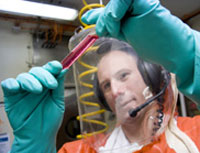



Technology Brings Biosecurity Experts Face-to-Face
AUSTRALIA - Responding to outbreaks of deadly animal-borne diseases promises to be quicker and easier with new technology allowing disease experts to work in real-time with chief veterinary officers across Australia.
CSIRO’s collaboration technology – on display at the CeBIT Australia tradeshow in Sydney this week – is in the process of being rolled out nationally.
The chief veterinary officers of Australia and Queensland will be the first to trial the system in June by linking with researchers at CSIRO’s Australian Animal Health Laboratory (AAHL) in Geelong, Victoria.
“When dealing with disease outbreaks, time is of the essence,” said research leader at AAHL, Dr Alex Hyatt.
“A high-speed, real-time interactive system will greatly improve the management of emergency animal disease outbreaks in Australia.”
At AAHL the platform is being used to interconnect researchers across a physical biosecurity containment barrier. The technology provides dual full high definition (HD) video conferencing and a shared workspace that provides secure, real-time access to critical technology such as microscopy, pathology and software applications on a display of over eight million pixels –four times that of the average desktop screen.
“We are now able to ‘meet’ with colleagues and share information such as pathology records, high-resolution maps and even view images on a microscope in real-time, easily and quickly,” Dr Hyatt said.
Before deployment of this collaboration platform, information was transferred via telephones, scanners and emails. At AAHL, doing anything more complicated – even just holding a meeting – meant going through a rigorous decontamination procedure to exit the facility, while veterinary managers had to travel interstate or use low-end video and/or telephone conferencing equipment, supplemented with print-outs.
| * "A high-speed, real-time interactive system will greatly improve the management of emergency animal disease outbreaks in Australia" |
|
Dr Alex Hyatt, research leader at AAHL
|
CSIRO's information and communication technologies (ICT) researchers are experts in human-computer interaction and have designed the platform with users in mind, so people in different locations can work together as if they were in the same room.
The platform’s uniqueness is achieved through a combination of off-the-shelf components, including four large display screens and two video cameras, and CSIRO-developed software with its simple on-screen controller.
The platform requires bandwidth of 12-60 Mbps. Those currently being installed in Queensland and the ACT are connected by AARNET, Australia’s high-speed fibre network connecting CSIRO, universities and other major research institutions.
CSIRO Director of eResearch, Dr John Taylor, said the next step will be to build ‘collaboratories’ which use CSIRO’s advanced collaboration technologies to enable scientists from around Australia and the world to work together to address the big science challenges.
“Cloud computing and high-speed networks will also play a significant role in building global-scale collaboratories to support scientific research.
“There’s a huge range of possible applications for this technology outside the research sector in education and working from home, for example, as high-speed networks become more widely available in Australia and around the globe,” Dr Taylor said.








